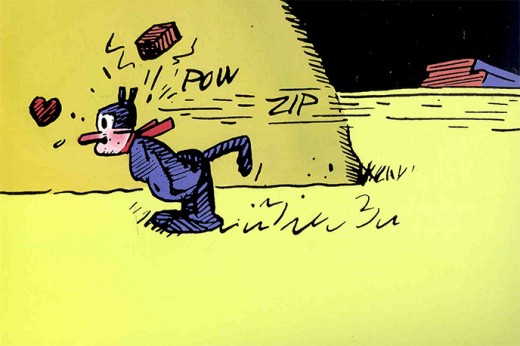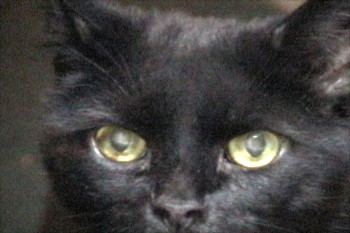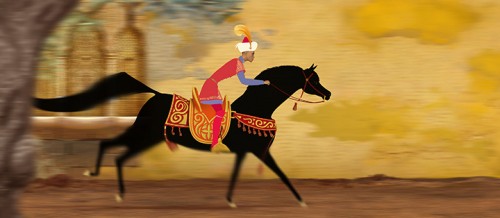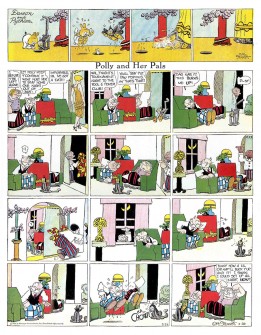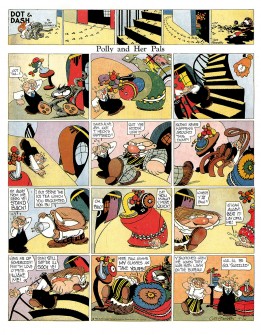Monthly ArchiveMay 2006
Daily post 20 May 2006 01:55 pm
Ruby, My Baby
Animation &Daily post &Pixar 20 May 2006 07:12 am
MOMA/CalArts
The Museum of Modern Art is honoring the work of CalArts with their upcoming film exhibition, TOMORROWLAND: CalArts in Moving Pictures May 25–August 13, 2006
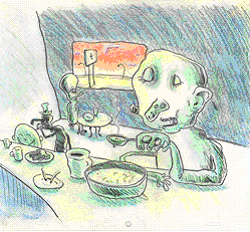 - The list of graduates from the school is impressive. They’ve been a real force in the worlds of animation, both traditional and experimental.
- The list of graduates from the school is impressive. They’ve been a real force in the worlds of animation, both traditional and experimental.
The extensive number of films to be screened include experimental films by: Stephen Hillenburg, Stephen Hillenburg, Larry Cuba, Gary Imhoff, Dennis Pies, Kathy Rose, & Joyce Borenstein.
Traditional 2D films by: Mark Kirkland, Henry Selick, Nancy Beiman, & JJ Villard
3D Entertainment films by: John Lasseter, Joe Ranft, Pete Doctor, Brenda Chapman, Mark Andrews, Doug Sweetland, Andrew Stanton, Ken Bruce, & Ralph Eggleston.
There are also quite a few live action films by graduates such as James Mangold who will have his own evening in which he’ll appear. Tuesday, May 23, 7:00 p.m
One curious title listed is: How to Read Macho Mouse. 1991 by Rubén Ortiz Torres, Aaron Anish. It’s described as a deconstruction of Speedy Gonzales, the Looney Tunes caricature of Mexican revolutionary Emiliano Zapata.
There’s an extensive article in Sunday’s NYTimes about this program of films.
- The PIXAR marketing pool is going strong. This article appears in Sunday’s NY Times about CARS. It’s in the Auto section.
Books &Festivals &Mary Blair 19 May 2006 06:26 am
Cannes & Walt’s People
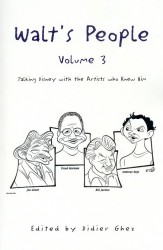 - In case you haven’t heard of Didier Ghez‘ three volume set of interviews published as Walt’s People Vols.1 & 2 and, just released, Vol. 3, you should look into it.
- In case you haven’t heard of Didier Ghez‘ three volume set of interviews published as Walt’s People Vols.1 & 2 and, just released, Vol. 3, you should look into it.
The books give a number of excellent in depth interviews with different artists who’ve worked with Walt Disney over the course of his career. They’re a wonderful tool for anyone interested in animation history and a good read for anyone interested in animation.
The most recent volume #3 includes interviews with: James Algar, Lee Blair, Joe Grant, Ben Sharpsteen, Bill Justice, Volus Jones, Ward Kimball, Burny Mattinson, Floyd Norman, and Bill Peet.
The first book features interviews with: Rudy Ising, Dave Hand, Bill Tytla, Ken Anderson, Jack Hannah, John Hench, Marc Davis, and Milt Kahl.
The second book includes: Friz Freleng, Grim Natwick, Frank Tashlin, Ward Kimball, Floyd Gottfredson, Frank Thomas, Eric Larson, and Woolie Reitherman
If you go to the Xlibris site, the primary distributor, you can get a sample of the interviews conducted within each of the books.
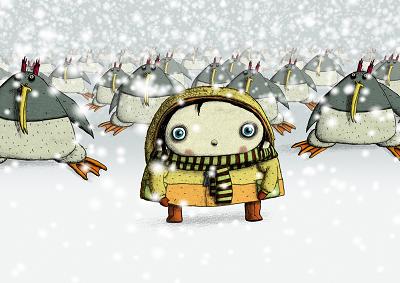 – The 2006 Cannes Film Festival, currently in progress, has only two animated shorts in competition this year. One French, one Swiss. They are:
– The 2006 Cannes Film Festival, currently in progress, has only two animated shorts in competition this year. One French, one Swiss. They are:
Icefloe is a Swiss animated film directed by Cédric LOUIS and Claude BARRAS.
The film tells the story of Marine, an obese young girl, who suffers from the heat of summer and the way other people look at her. She dreams of a better life among the penguins on an ice floe.
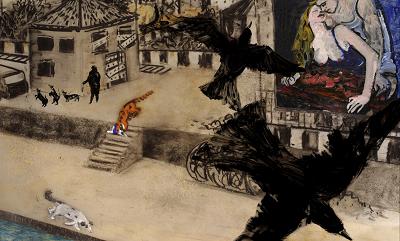 Conte De Quartier – A French film directed by Florence MIAILHE.
Conte De Quartier – A French film directed by Florence MIAILHE.
In a neighbourhood about to be torn down, construction wrecking ball in sight, seven characters cross paths. A rag doll with an inner secret is relayed from one character to another, creating a skein of tangled destinies inspired by tabloid news items.
Florence Miailhe used sand-and-oil-paint-on-glass animation and a digital camera to make the film. Technically it feels a bit like the style developed by Caroline Leaf in The Street.
You can see a sample of it here.
Neither film is listed in competition or Panorama at Annecy or Zagreb. Maybe Ottawa?
- Mark Mayerson has posted a fabulous letter by Dick Lundy, dated 1978, which gives a first person breakdown of his own career. It’s quite remarkable and an entertaining read.
Animation 18 May 2006 07:49 am
Ocelot At It Again
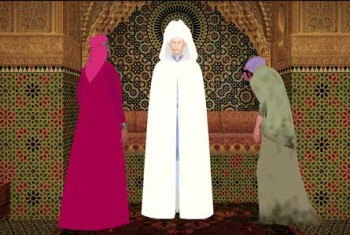 – French animation director, Michel Ocelot, is about to screen his new feature Azur et Asmar at the Cannes film festival Sun, May 21. Several production stills have been released as has some bits of information about the film. This material can be found on Twitch.
– French animation director, Michel Ocelot, is about to screen his new feature Azur et Asmar at the Cannes film festival Sun, May 21. Several production stills have been released as has some bits of information about the film. This material can be found on Twitch.
The film’s story tells a medieval tale of two youngsters, Azur and Asmar, separated in their youth, and of their lifelong rivalry. Their search for the Land of the Djinns, as told to them by their childhood nursemaid, reignites their childhood rivalry.
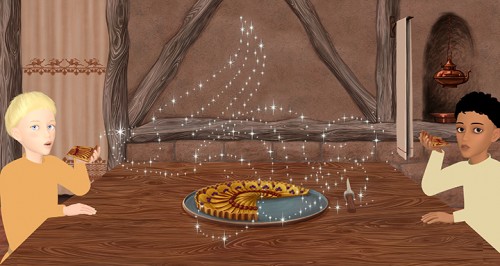
(Click on any image to enlarge.)
All of these images remind me of the paintings of Joan of Arc by Louis-Maurice Boutet de Monvel. Several of the paintings hang in the Corcoran Art Gallery in Washington D.C. The on-line images don’t do justice to those paintings. I encourage you to seek out the illustrated book. I have it in storage, but will post images when I can get it loose.
(What an odd notion that an animated film reminds me of something I saw in a museum, not something I saw on TV. I think I like it.)
- Once again Michael Barrier has an insightful commentary (May 17), this regarding Pixar’s output and their story development. Just as Lasseter, in the Fortune Magazine interview, says there is no difference between 2D & 3D technique – it all revolves around story, he has to start developing the stories as more than 2 dimensional characters that owe more to cliche than honest characterization.
The only problem I have with the notion of CARS is that I have no interest whatsoever in cars, just as I had no interest in fish when I saw Finding Nemo. That film never pulled me into the story then, and I’ll have to pull myself into a screening now. It feels like just another excuse for a loud, screaming sound track with shiny objects on screen. I hope I’m wrong.
- A short note that Lew Anderson, who was the final actor to play Clarabell the Clown on Howdy Doody, died yesterday at age 84. Obit.
Animation &Animation Artifacts 17 May 2006 07:52 am
Cats
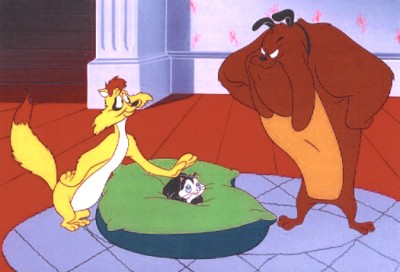 - One of my favorite Chuck Jones characters is Claude Cat, the second tier character he slowly developed in the 40′s.
- One of my favorite Chuck Jones characters is Claude Cat, the second tier character he slowly developed in the 40′s.
Debatebly, Claude made his debut in The Aristo-Cat in 1943 (one of my all-time favorite WB shorts). He looked quite different, but the germ of the character was there. By 1949, the cat had been fully developed and made his fully blossomed appearance in Mouse Wreckers with his frequent co-stars, Hubie & Bertie, two annoying mice.
Two of these Jones cartoons have been posted on You Tube. See Terrier Stricken or Two’s A Crowd. There’s also a posting by Jaime Weinman, who placed these two cartoons on You Tube and writes about them on his own blog.
I got my own cat when a friend adopted him and found that she couldn’t keep him. When she was immediately scratched and the kitten hid under her bed, I helped get him out, with the help of a ribbon. My friend had dubbed him “Claude” after she had been scratched, and I thought it appropriate to keep that name. Now he’s a husky 18 years old and still going strong. He’s sepia, not yellow.
- Speaking of cats, there’s a wonderful page over at Inspiration Grab Bag today. It’s an analysis of several Jim Tyer scenes from a Terrytoons short, A Cat’s Tale. These images are supposed to be animation analysis, but the Tyer drawings are just pure comedy. Thanks to Clarke Snyde for posting them and giving me something to laugh about this morning.
Animation Artifacts &Daily post 16 May 2006 07:24 am
Big Top Circus
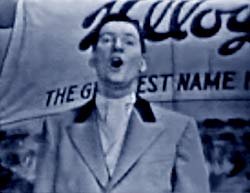 – There was a show on WOR-TV 9 in NYC when I was a kid.
– There was a show on WOR-TV 9 in NYC when I was a kid.
Claude Kirchner acted as ringmaster/host of the show. Kirchner was an off-screen announcer converted to on-screen host of the show. Originally it was called “Super Circus,” but when Kelloggs left as the show’s sponsor it changed its name to “Big Top Circus.” At other times the show was known as “Terrytoon Circus.”
Kirchner hosted the cartoon show with his papier-mâché sidekick puppet, “Clowny,” (you guessed it, he was a clown) a handpuppet with a non-changing face and a high-pitched, falsetto male voice. (I spent a lot of time waiting to see both Kirchner and “Clowny” on screen at the same time since I was sure he was doing the voice.) The only other people on the show weren’t on camera; they were the technical folk: cameramen, makeup, etc. You could hear them sometimes laugh off camera when there were big flubs by Kirchner, who always seemed to be shot in med CU. The show ended at 6:30pm each night with Kirchner saying “And now it’s time for all good little boys and girls to go to bed.”
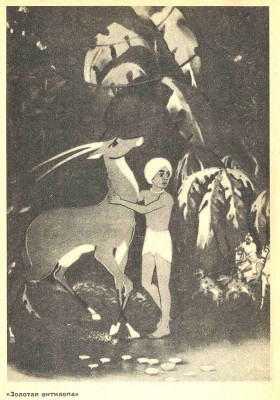 The attraction of the show for me was that they aired B&W cartoons that were not the typical WB cartoons over on WNEW, local ch 5 or the Popeye cartoons on WPIX, ch 11. These cartoons originally were silent Aesop Fables from Terry; eventually they became the B&W sound Terry cartoons of the 30′s. Gandy Goose, Farmer Alfalfa and Barker Bill.
The attraction of the show for me was that they aired B&W cartoons that were not the typical WB cartoons over on WNEW, local ch 5 or the Popeye cartoons on WPIX, ch 11. These cartoons originally were silent Aesop Fables from Terry; eventually they became the B&W sound Terry cartoons of the 30′s. Gandy Goose, Farmer Alfalfa and Barker Bill.
But for a short while, between the Aesop Fables and the sound Terrytoons, the show aired gems from Russia.
The original version of The Snow Queen before it was released as a feature from Universal in 1960, with songs and a new dubbing supervised by Dave Fleischer with the voices of Sandra Dee and Tommy Kirk. It was serialized, as was an Indian tale called The Golden Antelope. Both of these films were directed at Soyuzmultfilm by Lev Atamanov, and they both featured beautiful, rotoscoped-based animation.
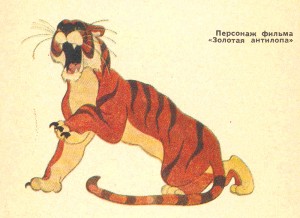 These beautifully crafted films were a real treat, and, as a kid, I grew to love some of these films with their majestic, long-maned horses.
These beautifully crafted films were a real treat, and, as a kid, I grew to love some of these films with their majestic, long-maned horses.
After getting into animation as a career, once I started collecting books and films, I sought out anything about these Russian cartoons.
These stills from The Golden Antelope are from a book entitled: Masters of Soviet Animation. It’s a small, Russian paperback published in 1971 and predates anything by Norstein. (click images to enlarge.)
Comic Art 15 May 2006 07:52 am
Polly Again
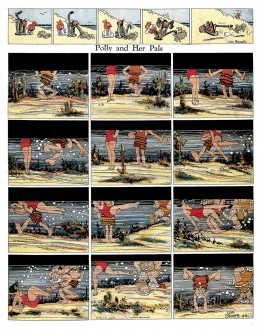 - Polly & Her Pals is the perfect strip to accompany any thoughts about the Group Theater.
- Polly & Her Pals is the perfect strip to accompany any thoughts about the Group Theater.
The strip originally followed the adventures of Positive Polly through the Jazz Age on her jaunts about town. The ideal flapper with her bobbed hair, short skirts and devil-may-care attitude.
Like several other strips, the side characters eventually took over as Maw and Paw adjusted to the nouveau riche lifestyle and spent the rest of their existence in a strip following Paw. Polly, like Nancy’s Aunt Fritzi Ritz, calmed down and became a good working girl once they hit the thirties, and the depression changed everything. The days of Jay Gatsby and found money settled into a more suburban world for the family as they moved into the 40′s.
(Click on any image to enlarge.)
What always separated Polly & Her Pals from other strips, such as Bringin’ Up Father or Nancy, was Cliff Sterrett’s delicious graphic styling. Taking clues from the art world in general, Sterrett morphed the world under the feet of his characters to capture their emotions; it became hilarious to read and delightful to look at.
Like the actors in the Group Theater, comic strips became more popularized; more concerned with the common man, or in the case of Polly, the common gal.
Animation Artifacts &Commentary 14 May 2006 08:21 am
What a Group!
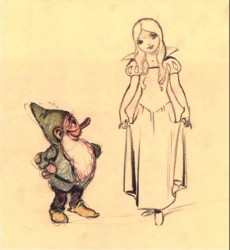 - I didn’t mean for yesterday’s post to turn into a “praise Grim Natwick” nor a “get on Art Babbitt” statement. I hope it didn’t come off that way.
- I didn’t mean for yesterday’s post to turn into a “praise Grim Natwick” nor a “get on Art Babbitt” statement. I hope it didn’t come off that way.
As I’ve said in the past, I treasure the drawings I have that were done by Art. I study and love every frame of any piece he’s ever animated. I just have more fun, personally – and I underline that word, personally, reviewing Grim’s animation.
I also didn’t say that Marlon Brando was a better actor than Laurence Olivier. They just came at it from different angles, and my preference has always been the more natural side of the acting world.
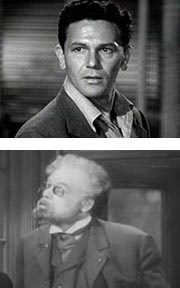 - Back in the late thirties when the Group Theater was formed, these actors went to Russia to search out Stanislavsky, an acting teacher who preached at the bible of natural movement – getting in touch with your inner soul to project through the acting.
- Back in the late thirties when the Group Theater was formed, these actors went to Russia to search out Stanislavsky, an acting teacher who preached at the bible of natural movement – getting in touch with your inner soul to project through the acting.
On Broadway, now, is a revival of Awake and Sing. Clifford Odets was a member of the original Group Theater, and his plays reflected their “common man” attitude to theatrical productions. They weren’t trying to do spectacles or Royalty plays, they were trying to project the “average Joe” back from the stage. It changed theater, created Henry Miller and a whole breed of acting styles. Compare, ex-Group Theater performer, John Garfield’s performances of the thirties with someone who was praised to the hilt back then, Paul Muni. Completely different acting styles – one natural and one overemotional and unrealistic.
The same was and is true of animators’ performances.
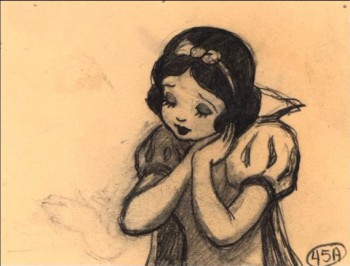 At Disney’s, these guys took their animation seriously. Some, such as Fred Moore and Norm Ferguson, thought they had it right and continued their own paths. Some looked into Stanislavsky and rejected it; others adopted it wholeheartedly. Still others, such as Grim Natwick, did it naturally and always had. Just as in the theater.
At Disney’s, these guys took their animation seriously. Some, such as Fred Moore and Norm Ferguson, thought they had it right and continued their own paths. Some looked into Stanislavsky and rejected it; others adopted it wholeheartedly. Still others, such as Grim Natwick, did it naturally and always had. Just as in the theater.
Next time you look at Fantasia, try just watching the acting styles. There’s nothing more Stanislavsky than Bill Tytla‘s scenes in Night On Bald Mountain, and there’s nothing less Stanislavsky than anything in the Pastoral.
Animation Artifacts &Commentary 13 May 2006 07:46 am
Theories
I have my own, odd thoughts about animators – great, master animators – these are the only ones I’m talking about.
I think there are two types of animator. Both types, I think, are brilliant but I have my preference. Basically it’s the same breakdown I have with live action actors: the difference between Laurence Oliver and Marlon Brando. Both are geniuses, but I’d go out of my way to see one of them more than the other.
One works from the outside in, and the other works from the inside out. It’s Royal Academy vs. Stanislavsky.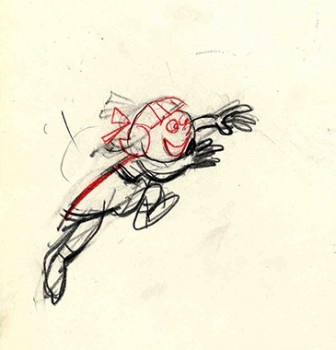
Animators:
– One is a brilliant mechanic of an artist who gets every pose every gesture just right. The movement of the character is perfectly flawless, the accents are always in the right place, the timing is perfect, and the weight captured is exact.
The character is developed but usually in a manipulated, studiously planned way. Usually, this animation, to me, is cold. Give the character a fake nose, and Laurence Olivier could be playing it.
(Art Babbitt, at the top of the triangle, is to me the model for this type of animator.)
(Natwick dwng from a Mountain Dew spot – click to enlarge.)
Then there is the emotional animator. The poses, gestures, actions of the character are emotionally executed by the animator as if this were the only way it could come out. The drawings are often violent and immediate – pencils ripping through paper and dark blotchy artwork.
This animator often puts emotion above mechanics, but (s)he digs to the depth of the part to find a real living thing. It isn’t always beautiful, but there’s a gem of a character on the screen. Like any living organism it’s unexpected and natural.
(Grim Natwick, to me, is the prime example of this type.)
No, I’m not saying if you draw dirty, rough, violent drawings you’ll be a great animator. I’m speaking somewhat metaphorically – although the two examples I gave actually did draw that way. I’m sure Art Babbitt did one or two rough, violent drawings in his life, but his animation feels tight, controlled, yet beautiful. Grim also did one or two clean drawings in his time – I have one, as a matter of fact, but his animation is controlled by his feelings, accumulated knowledge of craft, and emotions. It all feels immediate, spur-of-the moment. It’s alive!
I’ve only ever watched animated films with this guide going in the back of my head. Mind you, also, I have enormous respect for both of these types; it’s just that I prefer the emotional type. More than wanting my characters to think, I want them to feel.
My temptation, here, is to give the obvious list of animators and where they fall in my model, but I think for now I won’t. CGI also fits into this mold, but it’s not a great picture. I’m curious to hear what others think of this model.
